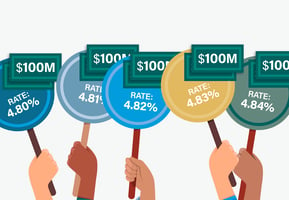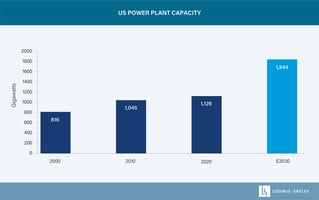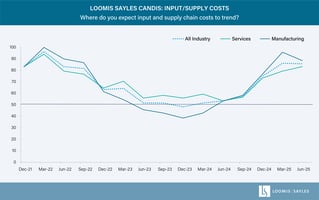
Loomis Sayles Municipal Marketplace
By Michael Skurka, CFA, Investment Director
Time to consider municipal bonds in lieu of money market funds?
We believe investors with assets in money markets currently earning an attractive yield face a conundrum: when to move out of money markets in an attempt to lock in relatively high current interest rates as the risk of lower rates in the future looms.
BACKGROUND
The updated Summary of Economic Projections (SEP) was released following the most recent Federal Open Market Committee (FOMC) meeting on June 12th, with FOMC members communicating a median view of only one rate cut of 25bps for the remainder of 2024, despite calling for three 25bps rate cuts at the March meeting earlier in the year. Interestingly, four members showed no rate cuts in 2024, seven with one cut, and eight with two cuts (the reason for the spread in the projection for rate cuts has been the wide spread in views on GDP growth and inflation this year driven by members’ differing economic forecasts, in our view).
FOMC members actually boosted the number of rate cuts expected next year from three to four, suggesting 100bps of rate cuts in 2025, while keeping three additional cuts totaling 75bps in 2026 resulting in a 3.1% Fed Funds target rate by the end of 2026. This is the same target rate forecast at the March meeting earlier in the year suggesting the FOMC simply shifted its rate cycle by one quarter.
After the release, the market’s reaction to all this was to price in two 25 basis point rate cuts for the remainder of the year, with the first potentially coming at the November 7th meeting, and the second potentially coming at the December 18th meeting, suggesting a 50bps decline in the Fed Funds rate and likely a corresponding decline in overall money market yields.
In our view, FOMC members and the market believe rate cuts are likely coming, with the decline in short-term interest rates not a matter of “if” but rather, “when”. And the likely answer to that question, in our view, is “soon”.
Figure 1: Based on the market implied Fed Funds rates below, the first 25bps cut would be estimated to come at the November FOMC meeting, while the second would come by the December meeting, resulting in approximately 50bps of decline by the end of the year.
MARKET IMPLIED FED FUNDS RATE (%)

Source: Bloomberg, as of 6/21/2024.
This material is for informational purposes only and should not be construed as investment advice. Information obtained from outside sources is believed to be correct, but Loomis Sayles cannot guarantee its accuracy. This material cannot be copied, reproduced or redistributed without authorization. Any opinions or forecasts contained herein reflect the current subjective judgments and assumptions of the authors only, and do not necessarily reflect the views of Loomis, Sayles & Company, L.P. This information is subject to change at any time without notice.
RELUCTANCE CAN BE REAL
To help combat potentially lower short-term rates, we think one option could be to extend out of money markets into longer-dated Treasurys or corporate bonds to lock in today’s yields for longer. However, because the Treasury and corporate bond yield curves are currently flat/inverted, there is likely some reluctance on investors’ part to make such a change because investors would likely still be getting approximately the same yield as money markets (possibly lower), but now would be taking on increased interest rate risk (See Figure 2 below).
Figure 2: Investors may be reluctant to move out of money markets and into Treasurys or corporate bonds given flat yield curves and increased interest rate risk.
US INVESTMENT GRADE CORPORATE AND TREASURY CURVES

Source: Bloomberg, as of 6/21/2024.
This material is for informational purposes only and should not be construed as investment advice. Information obtained from outside sources is believed to be correct, but Loomis Sayles cannot guarantee its accuracy. This material cannot be copied, reproduced or redistributed without authorization. Any opinions or forecasts contained herein reflect the current subjective judgments and assumptions of the authors only, and do not necessarily reflect the views of Loomis, Sayles & Company, L.P. This information is subject to change at any time without notice. Past market experience is no guarantee of future results.
WHERE TO GO FROM HERE
Another option for investors to consider is municipal bonds, although the attractiveness currently is somewhat dependent on an investor’s tax rate. For investors with a 20% tax rate, the taxable-equivalent yield of municipal bonds, according to the Bloomberg Municipal Bond Index, doesn’t stack up favorably against the yields on corporate bonds (See Figure 3 below).
Figure 3: For investors with a 20% tax rate, the tax benefit doesn’t compensate for the lower nominal rates.
TAXABLE-EQUIVALENT YIELD-TO-WORST
ASSUMING 20% TAX RATE

Source: Loomis Sayles, Bloomberg, as of 6/21/2024.
This material is for informational purposes only and should not be construed as investment advice. Information obtained from outside sources is believed to be correct, but Loomis Sayles cannot guarantee its accuracy. This material cannot be copied, reproduced or redistributed without authorization. Any opinions or forecasts contained herein reflect the current subjective judgments and assumptions of the authors only, and do not necessarily reflect the views of Loomis, Sayles & Company, L.P. This information is subject to change at any time without notice. Past market experience is no guarantee of future results.
For investors with a 30% Federal tax rate, municipal bonds begin to look attractive generally only if an investor is willing to take on substantial interest rate risk in the form of approximately 8 years of duration or more (see Figure 4 below).
Figure 4: For investors with a 30% tax rate, they may only see a benefit at the longer end.
MUNI TAXABLE-EQUIVALENT YIELD-TO-WORST
ASSUMING 30% TAX RATE

Source: Loomis Sayles, Bloomberg, as of 6/21/2024.
This material is for informational purposes only and should not be construed as investment advice. Information obtained from outside sources is believed to be correct, but Loomis Sayles cannot guarantee its accuracy. This material cannot be copied, reproduced or redistributed without authorization. Any opinions or forecasts contained herein reflect the current subjective judgments and assumptions of the authors only, and do not necessarily reflect the views of Loomis, Sayles & Company, L.P. This information is subject to change at any time without notice. Past market experience is no guarantee of future results.
However, investors with the highest Federal tax rate of 40.8% can currently reap the tax benefit of municipal bonds relative to corporate bonds even at the shortest maturities (see Figure 5 below).
The ability for investors with high marginal tax rates to increase after-tax income potential via municipal bonds, and actually be compensated to take increased interest rate risk, in our opinion should help ease investors’ reluctance to move out of money markets and into municipal bonds.
Figure 5: Investors with the highest federal tax rate may begin to see the benefit of higher taxable-equivalent yields of municipal bonds relative to corporate bonds even at the shortest maturities.
MUNI TAXABLE-EQUIVALENT YIELD-TO-WORST
ASSUMING 40.8% TAX RATE

Source: Loomis Sayles, Bloomberg, as of 6/21/2024.
This material is for informational purposes only and should not be construed as investment advice. Information obtained from outside sources is believed to be correct, but Loomis Sayles cannot guarantee its accuracy. This material cannot be copied, reproduced or redistributed without authorization. Any opinions or forecasts contained herein reflect the current subjective judgments and assumptions of the authors only, and do not necessarily reflect the views of Loomis, Sayles & Company, L.P. This information is subject to change at any time without notice. Past market experience is no guarantee of future results.
HIGHER AFTER-TAX YIELDS AREN’T THE ONLY POTENTIAL BENEFIT
In addition to potentially higher after-tax income potential, high tax-bracket investors can also potentially benefit from the increased duration added to the portfolio when moving out of money markets and into municipal bonds.
In the event of an unforeseen geopolitical incident or macroeconomic problem, market yields would likely fall as investors seek the ‘relative safety’ of fixed income. The Fed would likely respond to such an exogenous event by aggressively cutting short-term interest rates in a bid to support the economy resulting in short-term interest rates likely moving sharply lower in tandem.
In a lower rate environment, higher duration municipal bonds in an investor’s portfolio would likely gain value, all while having potentially locked-in higher yields via fixed coupon payments. Investors remaining in zero duration money market funds might see the value of their holdings remain stable, but we’d expect their future yields to fall as the short-term investments underlying the money market funds would mature and be re-invested in lower yielding securities.
CREDIT QUALITY MATTERS TOO
Finally, investors moving into municipals don’t have to sacrifice credit quality to do so. Currently, the average credit quality of the Bloomberg Municipal Index is AA/AA- while the average credit quality of the Bloomberg US Corporate Index is A-/BBB+. In our view, this highlights how the current taxable-equivalent yield benefit for municipal bonds doesn’t have to come at the cost of credit quality relative to corporate bonds.
So for high tax bracket investors evaluating options for moving out of money markets, they may want to consider high quality municipal bonds to potentially lock-in higher after-tax income relative to taxable alternatives and seek to hedge market uncertainty through longer duration bonds that could stand to gain value if interest rates move lower.
Let's Connect
Joshua Bogen, CMC
Director, Managed Account Strategies
JBOGEN@LoomisSayles.com
Jessica Hill
Private Wealth Advisor
JHILL@LoomisSayles.com
Andrew Scheirer
Managed Account Portfolio Specialist
ASCHEIRER@LoomisSayles.com
Key Risks
Municipal Risk, Credit Risk, Issuer Risk, Interest Rate Risk, Liquidity Risk, Derivatives Risk, Leverage Risk, Counterparty Risk, Prepayment Risk, Extension Risk and Management Risk.
Important Disclosures
This marketing communication is provided for informational purposes only and should not be construed as investment advice. Investment decisions should consider the individual circumstances of the particular investor. Any opinions or forecasts contained herein, reflect the subjective judgments and assumptions of the authors only, and do not necessarily reflect the views of Loomis, Sayles & Company, L.P. Investment recommendations may be inconsistent with these opinions. There is no assurance that developments will transpire as forecasted and actual results will be different. Data and analysis does not represent the actual, or expected future performance of any investment product. Information, including that obtained from outside sources, is believed to be correct, but we cannot guarantee its accuracy. This information is subject to change at any time without notice.
Indices are unmanaged and do not incur fees. It is not possible to invest directly in an index.
Loomis Sayles does not provide tax advice. Please consult with your financial advisor or tax professional.
Market conditions are extremely fluid and change frequently.
Any investment that has the possibility for profits also has the possibility of losses, including the loss of principal.
There is no guarantee that the investment objective will be realized or that the strategy will generate positive or excess return.
Past performance is no guarantee of future results.
For Investment Professional Use Only. Not For Further Distribution.
SAIFlpaea1f7


